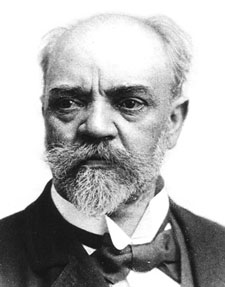Antonín Dvořák (1841-1904)
Born September 8, 1841 in Mühlhausen (Nelahozeves), Bohemia (Czech Republic).
Died May 1, 1904 in Prague, Bohemia.

Serenade in D minor for winds and strings, Op.44, B. 77
Composed: Jan 4, 1878 – Jan 18, 1878.
First Performance: November 17, 1878, Orchestra of the Provisional Theater (Prozatímního divadla), Prague conducted by the composer.
Instrumentation: 2 oboes, 2 clarinets, 2 bassoons, contrabassoon, 3 horns, ‘cello and bass.
Dvořák was born in Mühlhausen (Nelahozeves), Bohemia (today the Czech Republic) which is a small village 20 miles north of Prague.
In 1874 Dvořák applied to an Austrian government commission that provided financial aid to talented artists of limited means. The chairman was Eduard Hanslick who showed Dvořák’s music to Brahms who just became a committee member. Brahms sent Dvořák’s music to his own publisher Fritz Simrock which resulted in a commission for the Slavonic Dances Op. 46 which made Dvořák famous.
Dvořák planned to write three serenades. He wrote the first in 1875 for strings. The second for winds and lower strings was writing within the span of two weeks in January 1878. He never finished the third serenade.
Brahms was so impressed by the second serenade that wrote “a more lovely, refreshing impression of real, rich, and charming creative talent you can’t easily have.”
The instrumentation for this second serenade is unusual but not unique. It is likely that Dvořák knew Brahms’ Second Serenade Op.16 also omits the higher strings and flute.
The Serenade has four movements:
1. Moderato, quasi marcia
2. Minuetto. Tempo di minuetto
3. Andante con moto
4. Finale. Allegro molto
The first movement resembles a Mozart March but is permeated with Dvořák’s signature Czech vocabulary. It is in ABAB form.
Example 1. First Movement
The Second movement minuet and trio begins with a Bohemian sousedská which is a dance in triple meter. The Trio is a furiant – a fast syncopated Bohemian dance with shifting accents – based on a motif from the minuet.
Example 2. Second Movement

The romantic “lover’s duet” Andante third movement features a long sinuous melody that is shared between the oboe and clarinet above undulating chords in the horns.
The Finale is a Rondo which begins with a reworking of the March music from the first movement. There are several episodes including a Polka before the March theme reappears before launching into a brilliant coda.
Example 4. Fourth Movement

The first performance was conducted by Dvořák in Prague on his fifth wedding anniversary.
Resources
[amazon template=iframe image&asin=B0000040VK][amazon template=iframe image&asin=B0000041X8]
[amazon template=iframe image&asin=3795766729]

